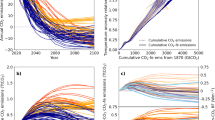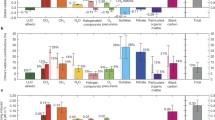Abstract
Climate policies must consider radiative forcing from Kyoto greenhouse gases, as well as other forcing constituents, such as aerosols and tropospheric ozone that result from air pollutants. Non-Kyoto forcing constituents contribute negative, as well as positive forcing, and overall increases in total forcing result in increases in global average temperature. Non-Kyoto forcing modeling is a relatively new component of climate management scenarios. This paper describes and assesses current non-Kyoto radiative forcing modeling within five integrated assessment models. The study finds negative forcing from aerosols masking (offsetting) approximately 25 % of positive forcing in the near-term in reference non-climate policy projections. However, masking is projected to decline rapidly to 5–10 % by 2100 with increasing Kyoto emissions and assumed reductions in air pollution—with the later declining to as much as 50 % and 80 % below today’s levels by 2050 and 2100 respectively. Together they imply declining importance of non-Kyoto forcing over time. There are however significant uncertainties and large differences across models in projected non-Kyoto emissions and forcing. A look into the modeling reveals differences in base conditions, relationships between Kyoto and non-Kyoto emissions, pollution control assumptions, and other fundamental modeling. In addition, under climate policy scenarios, we find air pollution and resulting non-Kyoto forcing reduced to levels below those produced by air pollution policies alone—e.g., China sulfur emissions fall an additional 45–85 % by 2050. None of the models actively manage non-Kyoto forcing for climate implications. Nonetheless, non-Kyoto forcing may be influencing mitigation results, including allowable carbon dioxide emissions, and further evaluation is merited.






Similar content being viewed by others
Notes
Aerosols can directly affect forcing as particles and indirectly affect forcing by facilitating formation of other elements that affect radiative forcing, such as clouds and troposhperic ozone.
Note that the overall EMF-27 study refers to RCP total forcing as AN3A forcing—total anthropogenic forcing minus the three excluded constituents.
Not all models reported PPP based income. Differences in PPP per capita GDP in China by the end of the century are $43,900 to $116,900.
Whether SO2 emission deviate from the reference starting in 2010 or 2020 depends on when the climate policy starts in each model.
References
Blanford G, Merrick J, Richels R, Rose S (2013) Trade-offs between mitigation costs and temperature change. Climatic Change. doi:10.1007/s10584-013-0869-2
Bond TC et al (2013) Bounding the role of black carbon in the climate system: A scientific assessment. J Geophys Res Atmos. doi:10.1002/jgrd.50171
Calvin et al. (2012) GCAM Wiki. http://wiki.umd.edu/gcam/
Carson RT (2010) The environmental kuznets curve: seeking empirical regularity and theoretical structure. Rev Environ Econ Policy 4(1):3–23
Clarke L, Edmonds J, Krey V, Richels R, Rose S, Tavoni M (2009) International climate policy architectures: Overview of the EMF 22 International Scenarios. Energy Econ 31(Supplement 2):S64–S81
Frank RH, Bernanke BS (2005) Principles of economics, 3rd edn. McGraw-Hill, New York
Forster P, Ramaswamy V, Artaxo P, Berntsen T, Betts R, Fahey DW, Haywood J, Lean J, Lowe DC, Myhre G, Nganga J, Prinn R, Raga G, Schulz M, Van Dorland R (2007) Changes in atmospheric constituents and in radiative forcing. In: Solomon S, Qin D, Manning M, Chen Z, Marquis M, Averyt KB, Tignor M, Miller HL (eds) Climate change 2007: the physical science basis. Contribution of working group I to the fourth assessment report of the intergovernmental panel on climate change. Cambridge University Press, Cambridge, United Kingdom and New York, NY, USA
Hourcade J-C et al (2001) “Global, regional, and national costs and ancillary benefits of mitigation”, Chapter 8 in Climate Change 2001: Mitigation—Contribution of Working Group III to the Third Assessment Report of the Intergovernmental Panel on Climate Change. Cambridge University Press, Cambridge, p 702
Kim SH, Edmonds J, Lurz J, Smith SJ, Wise M (2006) The ObjECTS framework for integrated assessment: hybrid modeling of transportation. Energy Journal (Special Issue #2) pp 51–80
Klimont Z, Smith SJ, Cofala J (2013) The last decade of global anthropogenic sulfur dioxide: 2000–2011 emissions. Environ Res Lett 8(1):014003
Kriegler E, Weyant JP, Blanford GJ, Krey V, Clarke L, Edmonds J, Fawcett A, Luderer G, Riahi K, Richels R, Rose SK, Tavoni M, van Vuuren DP (2013) The role of technology for achieving climate policy objectives: overview of the EMF 27 study on global technology and climate policy strategies. Climatic Change. doi:10.1007/s10584-013-0953-7
Leimbach M, Bauer N, Baumstark L, Edenhofer O (2010) Mitigation costs in a globalized world: climate policy analysis with ReMIND-R. Environ Model Assess 15(3):155–173. doi:10.1007/s10666-009-9204-8
Lu Z, Streets DG, Zhang Q, Wang S, Carmichael GR, Cheng YF, Wei C, Chin M, Diehl T, Tan Q (2010) Sulfur dioxide emissions in China and sulfur trends in East Asia since 2000. Atmos Chem Phys 10:6311–6331
Luderer et al., 2013. Description of the REMIND model (Version 1.5). http://www.pik-potsdam.de/research/sustainable-solutions/models/remind/description-of-remind-v1.5
MNP, 2006. A.F. Bouwman, T. Kram and K. Klein Goldewijk (eds.), Integrated modelling of global environmental change. An overview of IMAGE 2.4. Netherlands Environmental Assessment Agency (MNP), Bilthoven, The Netherlands
Moss RH, Edmonds JA, Hibbard KA, Manning MR, Rose SK, van Vuuren DP, Carter TR, Emori S, Kainuma M, Kram T, Meehl GA, Mitchell JFB, Nakicenovic N, Riahi K, Smith SJ, Stouffer RJ, Thomson AM, Weyant JP, Wilbanks TJ (2010) The next generation of scenarios for climate change research and assessment, Nature 463:747–756
Murphy DM, Solomon S, Portmann RW, Rosenlof KH, Forster PM, Wong T (2009) An observationally based energy balance for the Earth since 1950. Journal of Geophysical Research 114(D17107):1–14
Riahi K, Rao S, Krey V, Cho C, Chirkov V, Fischer G, Kindermann G, Nakicenovic N, Rafaj P (2011) RCP 8.5-A scenario of comparatively high greenhouse gas emissions. Clim Chang 109(1):33–57
Stern DI (2004) The rise and fall of the environmental Kuznets curve. World Dev 32(8):1419–1439
Stern DI (2005) Beyond the environmental Kuznets curve: diffusion of sulfur-emissions-abating technology. J Environ Dev 14(1):101–124
van Vuuren DP, Edmonds J, Kainuma M, Riahi K, Thomson A, Hibbard K, Hurtt GC, Kram T, Krey V, Lamarque J-F, Matsui T, Meinshausen M, Nakicenovic N, Smith SJ, Rose SK (2011) The representative concentration pathways: an overview. Clim Chang 109:5–31
Weyant JP, de la Chesnaye FC, Blanford GJ (2006) Overview of EMF-21: Multigas mitigation and climate policy. The Energy Journal (Special Issue: Multigas Mitigation and Climate Policy), 1–32
Author information
Authors and Affiliations
Corresponding author
Additional information
This article is part of the Special Issue on “The EMF27 Study on Global Technology and Climate Policy Strategies” edited by John Weyant, Elmar Kriegler, Geoffrey Blanford, Volker Krey, Jae Edmonds, Keywan Riahi, Richard Richels, and Massimo Tavoni.
Electronic supplementary material
Below is the link to the electronic supplementary material.
ESM 1
(PDF 438 kb)
Rights and permissions
About this article
Cite this article
Rose, S.K., Richels, R., Smith, S. et al. Non-Kyoto radiative forcing in long-run greenhouse gas emissions and climate change scenarios. Climatic Change 123, 511–525 (2014). https://doi.org/10.1007/s10584-013-0955-5
Received:
Accepted:
Published:
Issue Date:
DOI: https://doi.org/10.1007/s10584-013-0955-5




